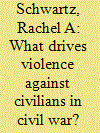| Srl | Item |
| 1 |
ID:
192651


|
|
|
|
|
| Summary/Abstract |
The use of agrarian reform within civil war to diminish insurgent support and violence has been a key topic within conflict scholarship, particularly in rural societies. Yet, this research has largely overlooked the ways in which the dynamics of counterinsurgency itself shapes land reform institutions – the procedures governing redistribution and legalization. Focusing on Nicaragua’s Contra War (1980–1990) and its longer-term effects, this article illustrates how counterinsurgent warfare can prompt state elites to refashion the rules of agrarian reform and titling in ways that ultimately undermine the state’s ability to regulate land tenure. As the perceived threat posed by the Contra insurgency deepened and peasant producers defected to rebels’ side, the highly centralized revolutionary coalition in power implemented alternative rules structuring land provision to recover rural support and preserve incumbent political power. These new rules permitted the individual and provisional titling of unregistered parcels, widening the property rights gap. The case thus illustrates that the obstacles to wartime agrarian reform may not emerge from state weakness or incompetence, but from how strategic wartime imperatives perversely remake the rules of land redistribution and titling.
|
|
|
|
|
|
|
|
|
|
|
|
|
|
|
|
| 2 |
ID:
158213


|
|
|
|
|
| Summary/Abstract |
Dominant theories of mass violence hold that strategic concerns in civil war drive the deliberate targeting of civilians. However, the causal mechanisms that link strategic objectives to large-scale violence against civilians remain underspecified, and as such the causal logics that underpin each remain blurred. In this article, we identify and explicate four plausible mechanisms that explain why armed groups would target, for strategic purposes, civilians in war. We then turn to the peak period of violence during the Guatemalan armed conflict to assess which mechanisms were most prevalent. Specifically, we leverage unique archival data: 359 pages of military files from Operation Sofía, a month-long counterinsurgent campaign waged in the northwestern Ixil region. Through process tracing of real-time internal communications, we find that state actors most commonly described the civilian population as loyal to rebel forces; violence against civilians was a means to weaken the insurgency. Troops on the ground also depicted the Ixil population as ‘winnable’, which suggests that security forces used violence in this period to shape civilian behavior. These findings are most consistent with the idea that mass violence in this case and period was a coercive instrument to defeat insurgents by punishing civilians for collaboration. The evidence from this period is less consistent with a logic of genocide, in which the purpose of violence would be to destroy ‘unwinnable’ civilian groups. Our analysis illustrates how a mechanism-centered approach based on process tracing of conflict archives can help uncover logics underlying civilian killing.
|
|
|
|
|
|
|
|
|
|
|
|
|
|
|
|